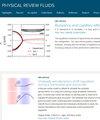Vortex dynamics in healthy and pro-atherogenic carotid artery bifurcation models
IF 2.5
3区 物理与天体物理
Q2 PHYSICS, FLUIDS & PLASMAS
引用次数: 0
Abstract
Carotid artery atherosclerosis is a significant contributor to mortality in the United States. While it is recognized that low wall-shear stresses trigger plaque formation, there is a limited comprehension of the internal vortical structures that impact these stresses and how they differ between a healthy and a disease-prone, high-risk patient cohort. Our objective is to determine which driving factors, such as anatomical features (artery geometry) and mass-flow split, govern vortex behavior. Physiological pulsatile flow computational fluid dynamics simulations were performed on a “healthy” and a “disease-prone” carotid artery bifurcation model. Geometry and flow effects are investigated separately by simulating a third hybrid model having a healthy geometry with outlet boundary conditions imposing disease-prone flow conditions. This “unhealthy ” model recreated disease-prone mass-flow split and internal carotid artery sinus axial pressure gradient conditions in a healthy carotid artery bifurcation geometry. The results of our study revealed that the main vortex's time of formation is primarily dictated by carotid artery bifurcation geometry, whereas its lifespan is determined by the flow conditions. The main vortex's spatial expansion, as well as its circulation decay rate, are dictated by the geometry, not the flow conditions. We conclude that a high internal carotid artery mass flow rate and a higher favorable pressure gradient maximum magnitude occurring near peak systole are strong indicators of a high predisposition towards atherogenesis.

健康和致动脉粥样硬化颈动脉分叉模型中的涡旋动力学
在美国,颈动脉粥样硬化是导致死亡的一个重要因素。虽然低壁切变应力会诱发斑块形成,但人们对影响这些应力的内部涡旋结构及其在健康和易患病的高危患者队列中的差异了解有限。我们的目标是确定哪些驱动因素(如解剖特征(动脉几何形状)和质量流分裂)会影响涡流行为。我们对 "健康 "和 "易患病 "的颈动脉分叉模型进行了生理搏动流计算流体动力学模拟。通过模拟第三个混合模型,分别研究了几何形状和流动的影响,该模型具有健康的几何形状,其出口边界条件施加了疾病易发的流动条件。这种 "不健康的 ΔP "模型在健康的颈动脉分叉几何形状中重现了疾病易发的质量流分裂和颈内动脉窦轴向压力梯度条件。我们的研究结果表明,主涡的形成时间主要由颈动脉分叉的几何形状决定,而其寿命则由流动条件决定。主涡的空间扩张及其循环衰减率由几何形状而非流动条件决定。我们得出的结论是,颈内动脉质量流量大以及在收缩高峰附近出现的有利压力梯度最大值较高,是动脉粥样硬化发生倾向性高的有力指标。
本文章由计算机程序翻译,如有差异,请以英文原文为准。
求助全文
约1分钟内获得全文
求助全文
来源期刊

Physical Review Fluids
Chemical Engineering-Fluid Flow and Transfer Processes
CiteScore
5.10
自引率
11.10%
发文量
488
期刊介绍:
Physical Review Fluids is APS’s newest online-only journal dedicated to publishing innovative research that will significantly advance the fundamental understanding of fluid dynamics. Physical Review Fluids expands the scope of the APS journals to include additional areas of fluid dynamics research, complements the existing Physical Review collection, and maintains the same quality and reputation that authors and subscribers expect from APS. The journal is published with the endorsement of the APS Division of Fluid Dynamics.
 求助内容:
求助内容: 应助结果提醒方式:
应助结果提醒方式:


